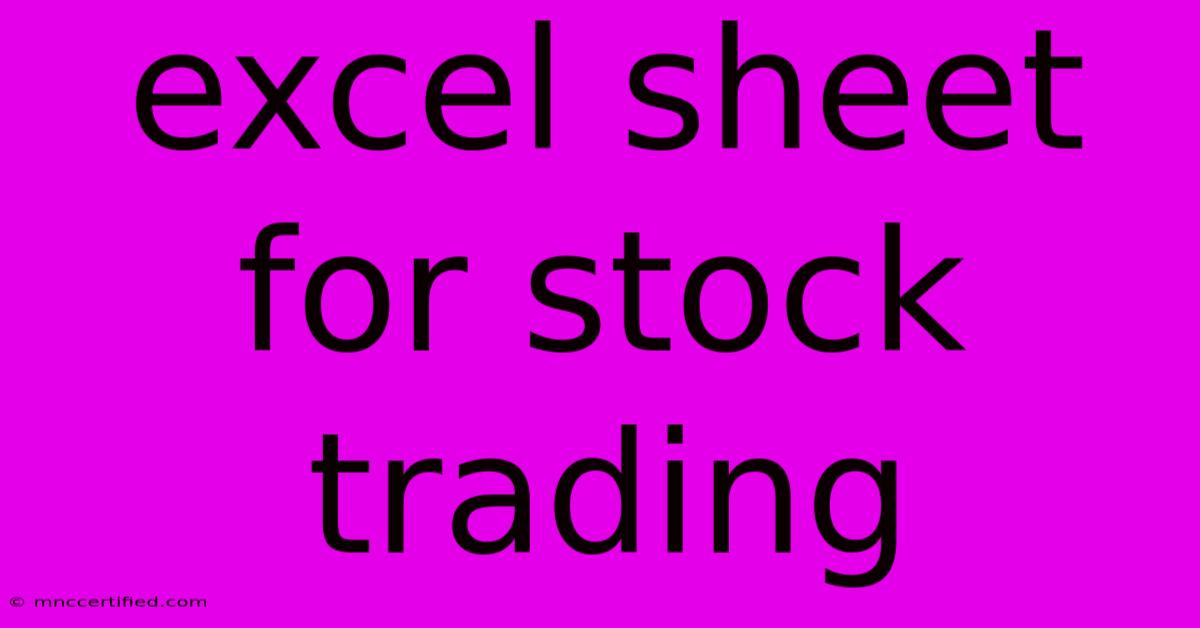Excel Sheet For Stock Trading

Table of Contents
Excel Sheet for Stock Trading: The Ultimate Guide to Building Your Own
Are you ready to take your stock trading to the next level? While many traders rely on expensive software, a well-designed Excel sheet for stock trading can provide a powerful and customizable tool to manage your portfolio, analyze performance, and make informed decisions. This guide will walk you through creating your own, covering everything from basic setup to advanced features.
Why Use an Excel Sheet for Stock Trading?
Before diving into the specifics, let's explore the advantages of using Excel for stock trading:
- Cost-effective: Unlike proprietary trading software, Excel is readily accessible and affordable.
- Customization: Tailor your spreadsheet to your specific trading needs and strategies. Add formulas and features that align perfectly with your approach.
- Transparency: You have complete control over the data and calculations, promoting a deeper understanding of your portfolio's performance.
- Offline Access: Unlike web-based platforms, your data remains accessible even without an internet connection.
- Learning Opportunity: Building your own spreadsheet enhances your understanding of financial concepts and formulas.
Building Your Basic Excel Stock Trading Sheet: A Step-by-Step Guide
This section outlines the creation of a foundational spreadsheet. Remember, you can always expand and customize it later.
1. Setting up Your Columns
Begin by creating the following columns:
- Ticker: The stock symbol (e.g., AAPL, MSFT).
- Company Name: The full name of the company.
- Purchase Date: The date you bought the stock.
- Purchase Price: The price per share you paid.
- Quantity: The number of shares purchased.
- Total Cost: (Quantity * Purchase Price) This formula automatically calculates your total investment.
- Current Price: You'll manually update this column regularly. Use a reliable source like Google Finance or Yahoo Finance.
- Current Value: (Quantity * Current Price) This formula calculates the current value of your holding.
- Profit/Loss (P/L): (Current Value - Total Cost) This shows your profit or loss per stock.
- P/L Percentage: ((Current Value - Total Cost) / Total Cost) * 100. This provides the percentage change.
2. Essential Formulas
The formulas mentioned above are crucial. Here's how to implement them:
- Total Cost:
=C2*D2(assuming Quantity is in column C and Purchase Price in column D. Adjust accordingly for your column layout.) - Current Value:
=E2*G2(assuming Quantity is in column E and Current Price in column G. Adjust accordingly.) - P/L:
=H2-F2(assuming Current Value is in column H and Total Cost in column F. Adjust accordingly.) - P/L Percentage:
=(H2-F2)/F2*100(using the same column assumptions as above.)
3. Adding More Features
Once you have your basic structure, consider these additions:
- Dividend Yield: Include a column to track dividend payments.
- Transaction Fees: Account for brokerage fees in your P/L calculations.
- Investment Strategy: Add columns relevant to your chosen strategy (e.g., stop-loss price, target price).
- Charts and Graphs: Use Excel's charting tools to visualize your portfolio's performance.
Advanced Techniques and Considerations
- Data Import: Explore options to automate data entry using web scraping tools or APIs (Application Programming Interfaces) to pull real-time stock prices. This requires some programming knowledge.
- Portfolio Diversification: Use formulas to calculate your portfolio's diversification across different sectors and asset classes.
- Risk Management: Develop formulas to assess your portfolio’s risk based on volatility and correlation between assets.
- Backtesting: While challenging in Excel, you can use it for simple backtesting strategies by manually inputting historical data.
SEO Considerations for Your Excel Stock Trading Sheet
While this article focuses on building the spreadsheet itself, remember that if you're sharing your knowledge or a template online, SEO is crucial. Use relevant keywords like "Excel stock trading template," "free stock portfolio tracker," "stock market spreadsheet," "investment tracking excel," "build your own stock tracker," etc. throughout your content and meta descriptions.
Remember to optimize your title tags and meta descriptions accurately. Create high-quality content, use relevant images, and consider building backlinks from reputable financial websites to improve your search engine ranking.
This comprehensive guide provides a solid foundation for building your own powerful Excel sheet for stock trading. Remember to always double-check your formulas and regularly update your data for accurate analysis and informed decision-making. Happy trading!

Thank you for visiting our website wich cover about Excel Sheet For Stock Trading. We hope the information provided has been useful to you. Feel free to contact us if you have any questions or need further assistance. See you next time and dont miss to bookmark.
Featured Posts
-
Allegri Seen At Spurs Vs Roma
Nov 29, 2024
-
4600 Investment Drive Troy Mi
Nov 29, 2024
-
Life Changers Investments Llc
Nov 29, 2024
-
Live Black Friday Deals 2024 Glamour Picks
Nov 29, 2024
-
Injury Blow For Giants Before Thanksgiving
Nov 29, 2024